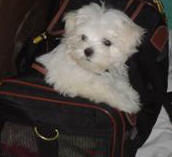
Click on
Library Icon
to learn more
|
What is a kennel?
A kennel can be made of molded
plastic, wire, or cloth. What's
important about a kennel is that it's
designed to be viewed by dogs as a
natural den. Dogs like wolves are "den" animals.
How to
introduce the kennel
 When the
kennel is first presented to an
older dog, you may want to offer only the bottom
half or leave the door open so
that the dog may go in and out
freely. Make sure you provide a
very comfortable bed or resting
pad inside. The best pad fits
the kennel exactly so that the
dog is not tempted to chew the
pad's edges. Pad covers
typically have a fleece side for
warmth and a nylon side for
cooling to be flipped as the
seasons change. When the
kennel is first presented to an
older dog, you may want to offer only the bottom
half or leave the door open so
that the dog may go in and out
freely. Make sure you provide a
very comfortable bed or resting
pad inside. The best pad fits
the kennel exactly so that the
dog is not tempted to chew the
pad's edges. Pad covers
typically have a fleece side for
warmth and a nylon side for
cooling to be flipped as the
seasons change.
Initially, you may need to
convince dogs that kennels are
their very own private dens and
safe havens. Begin by keeping
the door open at all times. Feed
the dog inside the
kennel, and place treats and
toys inside it during the day.
If training an older dog,
contrast no attention when the dog
is OUTSIDE of
the kennel during the teaching
phase with tons of attention
when the dog is INSIDE the kennel,
making it clearly worth the dog's
while. Click here for
Kennel Training Steps
You may
need to withhold your attention,
praise and toys for when the dog
is INSIDE the kennel to make
these goodies more valuable.

TIP: If
you do not have water for 12 hours,
then water has more value. If your
dog does not get your attention
around the clock, your attention has
more value.
Exercise
tough love by ignoring the dog
when he or she is outside the
kennel. If practical, keep the
kennel near you during the day
and in your bedroom at night.
|
The kennel is used for house
training, preventing
destruction, and protecting
the dog from household
dangers. The goal is to
teach the dog that his or
her kennel is the most
comfortable place to be. |
Once the dog will go
in the kennel often on his or her own free will,
then begin to close the door of the kennel while the
dog is eating. Stay right there and praise the dog
for accepting this next phase. Open the kennel while
the dog is still showing happy, relaxed behavior.
Gradually, increase the time the door is closed.
Stay close but begin to phase out continual praise
by silently counting from 1 to 5, then 10, etc., in
between singing the dog's praises.
Always provide a
chew toy and rotate other playful toys inside the
kennel. If the dog is barking to get out, try to get
the dog to be quiet for at least 5 seconds before
opening the door. This can be done be asking the dog
to "sit," or, to respond to the "quiet"
instruction. If the first two techniques do not work,
distract the dog by doing something like jiggling
the handle of the kennel or making another noise to
interrupt the barking. This way you reward the quiet
and not the barking.
"Kennel
up"
When the dog enters the kennel,
say, "Kennel up!" in a
happy, upbeat voice. Later, you
will use this cue to mean,
"Enter your kennel now please."
Here's a fun game to play.
Before a meal, take the first
few kibbles and toss them one by
one into the kennel. Say,
"kennel up" as your dog goes
inside to eat the kibble and
praise the dog. Then, say "come"
as the dog comes out of the
kennel and give another kibble
and praise. Repeat this game
several times at each meal until
"Kennel up!" results in
your dog running happily in and
out of the kennel.
Elimination training
Keep the dog under immediate
supervision for playtime and
companionship and then put the
dog back inside the kennel. Once
the dog has earned your trust,
gradually increase the amount of
time that the kennel door is
left open and the dog is allowed
access to the rest of the house.
 TIP:
Use baby gates to keep the dog inside of
a kitchen. The kennel becomes the
most comfortable place for the dog to
nap. If the dog has an accident during
housetraining, it will be easy to clean.
(If dogs smell a spot of urine on the
carpet, they are more likely to go again
in that spot.)
At night, allow no food
or drink for at least 2 hours
before bed. TIP:
Use baby gates to keep the dog inside of
a kitchen. The kennel becomes the
most comfortable place for the dog to
nap. If the dog has an accident during
housetraining, it will be easy to clean.
(If dogs smell a spot of urine on the
carpet, they are more likely to go again
in that spot.)
At night, allow no food
or drink for at least 2 hours
before bed.
As the dog earns your
trust, he or she can be allowed
access to increasingly more
sections of the house. You
must take the dog out and NOT expect the
dog to signal you. Not all dogs learn to
go to the door. Some people miss this
signal anyway.
Once you have established a routine
and there have been no accidents for a
couple of weeks, expand into one more
area at a time. After the dog is
"proofed" in every room in the house,
you will be able to leave the door to
the kennel open most of the time since
the dog has earned
the privilege to be free in the
house.
Contented confinement gives a
dog more freedom
A dog that has learned contented
confinement can be with you
more. When you travel, he or she
can likely go along. Kenneled
dogs in molded plastic kennels
are safe traveling in cars and
planes, and are often accepted
at motels. If company comes over
and the dog is too excitable,
the kennel becomes his or her
"safe place" to chill. If young
children are too fascinated with
the dog, kenneling your dog may
keep both the children
and the dog safe.
|